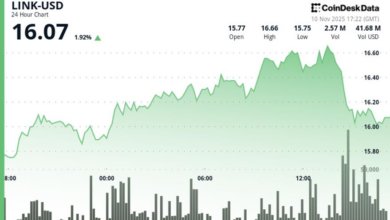At $2.1T market cap, what causes Bitcoin price to move up or down in 2025?

تكنلوجيا اليوم
2025-11-10 18:10:00
Behind every wild Bitcoin candle in 2025 is a quiet shift in collateral, basis, and ETF flows.
Funding rates, margin haircuts, and spot ETF hedging now have as much impact on the price as any macroeconomic headline.
Collateral settings across futures and lending venues influence the Bitcoin spot price through forced hedging and liquidations. The October shakeout put the link back in view, with approximately $19 billion of positions liquidated on October 10–11 as funding and basis compressed and then reset.
October’s shakeout in funding, collateral, and ETF flows
Since mid-September, exchanges have also adjusted funding formulas and collateral parameters, altering carry economics and liquidation thresholds for margin trading. The macro hurdle for carry has eased after the Federal Reserve’s late-October cut and a move in three-month bills toward about 3.8%.
ETF and ETP flows also fluctuated during October, shifting from record inflows to outflows and back, which in turn affects spot inventories and dealer hedging flows.
However, that October pattern has already reversed again: by early November, CoinShares data show digital asset funds experiencing renewed net outflows, led by nearly $1 billion out of Bitcoin ETFs, emphasizing how quickly ETF hedging flows can change direction.
The mechanism is straightforward. When the perpetual or futures premium widens, basis traders buy spot and short perps or listed futures to lock the spread. That pulls coins off exchanges, tightens resting liquidity, and lifts the cash print.
When funding turns negative and the basis compresses, the same books unwind by selling spot and covering short-perpetuals, which adds inventory to exchanges and puts pressure on the price. Funding is tied to the perp premium versus the underlying index and is settled at fixed intervals.
In late October, medium-term annualized basis on March BTC futures was running around 6–6.5%, a few hundred basis points above three-month bills.
How tighter basis, funding, and haircuts feed back into spot
That pickup has since compressed, with March basis now closer to the mid-5% area and only about 150–200 bps over bills, still enough to keep carry capital engaged as long as borrow costs are controlled and collateral haircuts remain unchanged.
Financing and haircuts determine how much leverage that spread can support. Borrow costs on DeFi remain low in places, with Aave v3 WBTC borrow near 0.2% and low utilization, according to Aavescan.
Centralized venues exhibit a wide dispersion in margin borrow rates for BTC and stablecoins, which can either erode or enhance net carry. Haircuts and portfolio margin settings then determine how far positions can extend before the maintenance margin is triggered.
A change in a collateral ratio or a funding clamp shifts the liquidation bands closer to or further from the spot, and venues have made such adjustments through September and October.
Liquidations and insurance funds serve as accelerants. Maintenance-margin math can force exits on small percentage moves at high leverage, and insurance funds absorb losses until thresholds are reached.
In a prior episode in 2023, dYdX tapped about $9 million from its v3 insurance fund to absorb losses in the YFI market, with balances remaining, illustrating how these buffers throttle, rather than remove, deleveraging pressure.
The Oct. 10–11 cascade demonstrated how perp leverage transmits to the cash market quickly as positions are forced out.
The liquidity backdrop: exchange reserves, depth, and carry capacity
On the other side of the book, exchange reserves and depth shape how these flows print. CryptoQuant’s dashboard shows Bitcoin exchange netflows at three-year extremes, with sustained outflows that have pushed exchange reserves to multi-year lows in October.
This reduction in the for-sale supply occurs when basis draws coins off-venue and then feeds back when the unwinding of that flow reverses.
Kaiko’s earlier depth study pegs 1% BTC market depth at about $500 million, a useful yardstick for how a $1 billion basis-driven spot bid could traverse multiple buckets intraday if passive liquidity steps back, according to Kaiko.
Capacity for the short leg of carry remains available on regulated venues, with CME reporting record crypto futures open interest and volumes as of late October.
Carry math helps frame participation. A simple delta-neutral template is: net carry equals annualized basis minus financing cost minus fees and slippage minus any borrow APR.
For example, with a 6.3% medium-term basis (roughly where March traded in late October) and a 3.8% bill rate, a cash-financed book yields roughly 2.5% before considering frictions. If a desk funds with an exchange stablecoin and borrows at 3–6%, the same spread can fall near zero or even go negative after fees.
For perps, eight-hour funding annualizes by multiplying by three, then by 365, so a 0.01% eight-hour rate works out to about 11% per year, according to ApeX.
How collateral, basis, and ETF flows now drive Bitcoin’s spot price
Haircuts map directly to leverage. If effective leverage scales with the sum of initial margin and the haircut applied to collateral, a 5–10 percentage point haircut increment can reduce usable leverage by roughly 10–20% and lift liquidation risk, forcing de-risking flows even without a price change.
ETP and ETF activity is the other valve. CoinShares reported $5.95 billion of inflows in the week ending October 4, followed by $513 million of outflows in the week of October 20, and then $921 million of inflows in the week of October 27, which altered dealer hedge requirements and the spot bid within days.
When those flows run positive while the basis is wide, carry desks compete with ETF creations to source coins, and exchange balances trend lower. When flows flip or funding turns negative, the unwind adds to reserves and pushes the price toward liquidation clusters.
Over the next month, three paths matter for spot.
- If the basis expands to 8–12% for several sessions, carry desks typically add long spot and short perps or CME, which drains exchange balances and can keep funding positive until new inventory arrives.
- If the basis compresses to 3% or less and ETF flows turn negative over several days, the unwind pushes spot supply back onto exchanges and concentrates pressure around maintenance-margin bands.
- A haircut or portfolio-margin update can produce faster de-risking, even without a macroeconomic shift, since collateral value falls, effective leverage drops, and the same price range triggers liquidations.
These outcomes depend on where the spread sits relative to the bill rate, the cost of borrowing, and the direction of ETF flows.
Three real-time gauges for Bitcoin’s next move
For real-time context, watch three gauges.
- An annualized basis above 8% on medium tenors for more than a day or two often attracts new carry demand.
- A broad patch of negative funding across major perps on the CoinGlass heatmap lines up with spot selling and reserve rebuilds as basis books unwind.
- Support-center posts on collateral ratios or portfolio margin changes provide early warnings of leverage clamps.
The practical takeaway is that options are not required to push the cash market around when basis, funding, borrow, and haircuts reset together. With a basis now around 5–5.5% over bills, the carry door remains open but is more sensitive to shifts in collateral demand and borrowing costs.





